








Thank you to members of the Best Practices Committee for your support in the development of this literacy strategy.
Kim McLean, Principal
Paige McDonald, Manager of the Read/Write & Math department
Karen Monner, Assistant Manager of the Read/Write & Math department
Melanie Reader, Manager of the Psychological Services & Programs
Sean Horton, Vice-Principal
Tanya Keto, Manager of the Professional Development & Community Education

Ashley Barber, Vice-Principal
Lindsey Bingley, Literacy and Numeracy Lead
Simon Williams, MSEd. Executive Co-Director
 Karen MacMillan, PhD, R. Psych Executive Co-Director
Karen MacMillan, PhD, R. Psych Executive Co-Director
What is an effective Literacy Strategy?
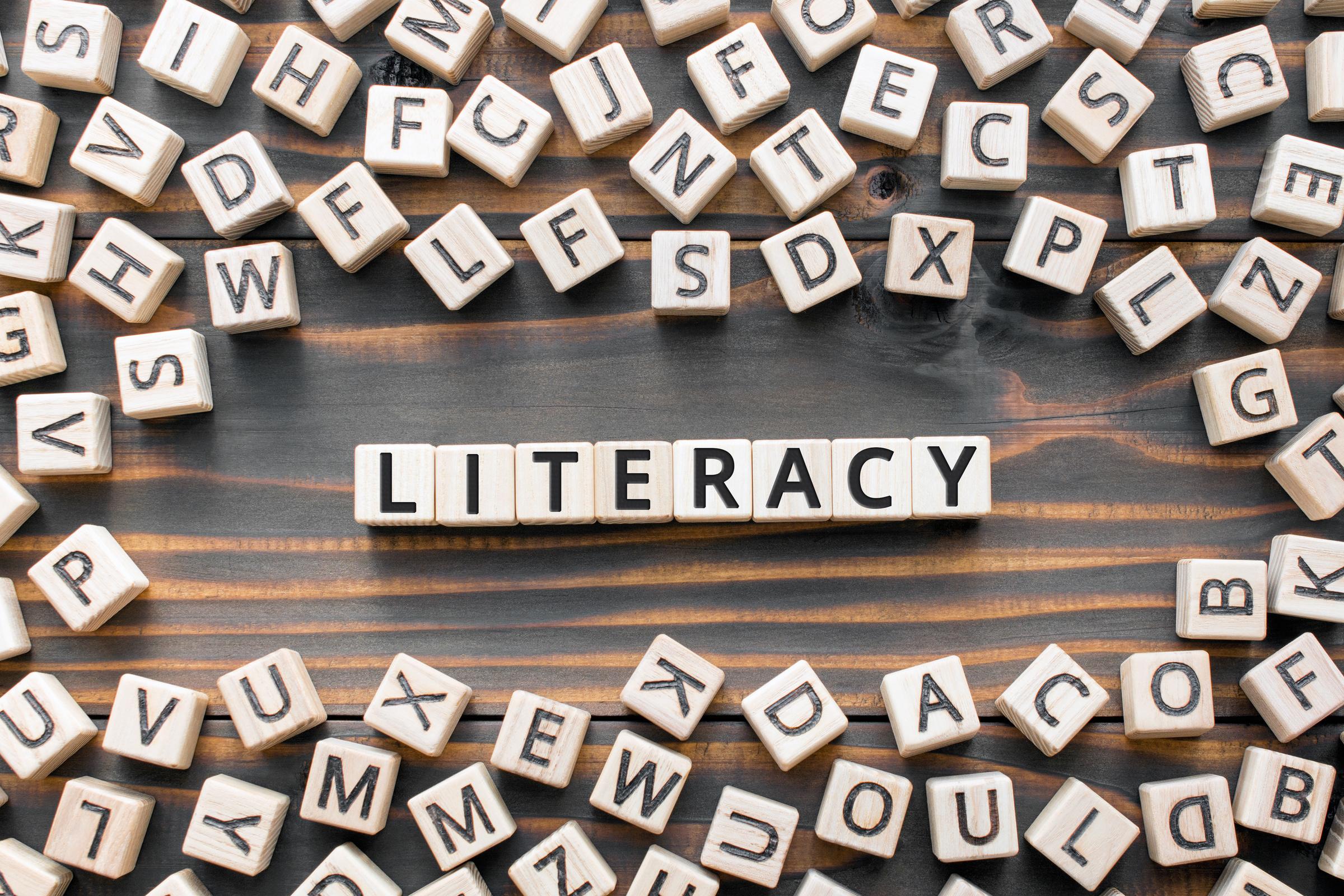
An effective literacy strategy is based on a philosophical stance held by an agency, or school, and clearly explains the repertoire of instructional procedures (teaching strategies) and the decision-making process for the choice of procedures These teaching strategies serve to help students build learning strategies so that they might decode and comprehend what they are reading and writing.
What is the Literacy Strategy at Foothills Academy Society?
Foothills Academy Society uses a Structured Literacy strategy based on the science of reading Through regular and routine assessment, individual learning needs are identified and addressed in one of three ways: the student works with their classmates in a 10-week skills period, the student works in a smaller pullout group within the skills period, or the student is pulled out for 1:1 work or small group work (2-4 students) for specialized remediation for the 10week skills period Our goal is to meet each student where they are and strengthen their skills using the same language at each level of instruction. We are delivering well-timed and targeted instruction that allows kids to take in the enormous amounts of information they receive in the classroom.
What programs do we use at Foothills Academy Society?
We use programs created by Wilson: Just Words, Fundations, and the Wilson Reading System; Lindamood Bell: Visualizing and Verbalizing, LiPS, and Seeing Stars; Step up to Writing; and Lexia These programs are all evidence-based and provide a structure for strategic instruction
How did we decide on this strategy?
Students with Learning Disabilities require remediation and accommodation - the correct balance of these is child specific, and related to the child’s age, co-existing challenges, and severity of symptoms Whenever possible, the focus should be on remediating pathways in the brain, instead of compensating for them Throughout our lives – but particularly at younger ages – our brains have neuroplasticity, or the ability to change and adapt both structure and function.
"In cases where disability is severe, there is a need to provide compensatory approaches so children with special needs can access the curriculum (e.g., reading support in science class), but given our knowledge of neuroplasticity, strategies designed to reduce this compensatory dependence should also be undertaken" (Hale et al., 2016, p. 47).
Whenever possible, we want to engage students in learning that provide intensive intervention to support their learning and ultimately create new pathways in their brain. Intensive remedial intervention requires attention to factors such as the “dosage” of instruction – the frequency, duration, and latency time (Stevenson & Reed, 2017). For example, repeated practice of difficult tasks over time can lead to automaticity which frees us space in the brain for higher level operations
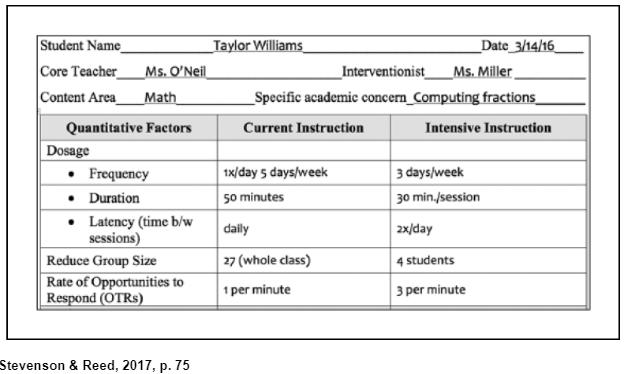

At some point in Foothills history there was a decision to move away from the Orton-Gillingham approach. However, the Read/Write & Math department in Community Services did adopt the Lindamood Phoneme Sequencing (LiPS) program in order to provide one-to-one remedial instruction which has made a profound impact on the trajectory of thousands of lives for decades. Published research has confirmed the benefits of Foothills’ Read/Write & Math program: “Significant improvements were found in the areas of nonword decoding, phonological awareness, and spelling following the reading remediation program” (Dick, Kaplan, & Crawford, 2006, p.106). In the School, we have incorporated the LiPS program within the school in various ways over the years.

In 2000, the report of the National Reading Panel highlighted five (5) “pillars” of reading:
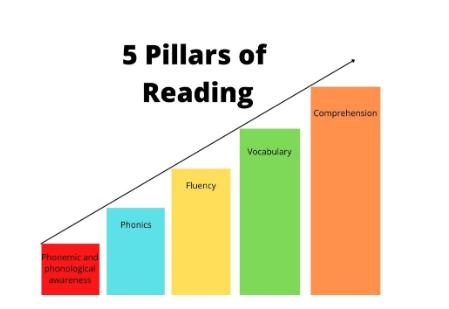 When Foo of Denver reading ins Anderson, subsequen Academy).
When Foo of Denver reading ins Anderson, subsequen Academy).

Since its in Academy h literature o that has be the lack of very comp
The curren accumulated understanding from high quality research on rea acquisition and instruction (eg, Seidenberg, Borkenhagen, & Kearns, 2020). It is not a specific methodology or system for tea reading
The Science of Reading tells us:
Most reading difficulties can be prevented in young students who are at risk. Studies have demonstrated the effectiveness of intensive phonemic awareness training, intensive phonic decoding training, and opportunities for repeated practice with reading controlled text. Intervention in these skills leads to efficient orthographic mapping and the highest degree of success. Teaching whole-word memorization is limited. Learning phonics empowers students with an exponential effect.
Reading development can be divided into three stages:

Letters and sounds
Phonic decoding
Orthographic mapping
Letter-sound knowledge is essential for both phonic decoding and sight-word learning
Early phonological awareness skills enable the development of letter-sound knowledge and should be targeted for direct instruction. Advanced phonological awareness skills should continue to be assessed and practiced to ensure that a solid orthographic lexicon is established.

Understanding orthographic mapping allows for teachers to support students who struggle to read. Orthographic mapping is the process that occurs when unfamiliar words become automatic sight words. The research on orthographic mapping explains how students develop this vast sight word bank for accurate and automatic word retrieval and also why students with reading problems struggle to develop this skill. Phonics and phonemic manipulation must be proficient to allow for students to build a sight word bank or orthographic lexicon. To support this, students need sufficient practice and review in decoding and encoding, knowledge and application of concept skills, and exposure to decodable text. Comprehension is the ultimate goal for reading It is driven by two broad skillsets that are identified in the Simple View of Reading.


The Science of Reading tells us (Continued):

The Simple View of Reading is further detailed in Scarborough’ e, which highlights the essential components of reading.


Learning to spell is far more complex than just memorizing words. E g) is a developmental process that impacts fluency, writing, pronunciation
“The Science of Reading (SoR) is a comprehensive body of research that encompasses years of scientific knowledge, spans across many languages, and shares the contributions of experts from relevant disciplines such as education, special education, literacy, psychology, neurology, and more. The Science of Reading has evolved from a wide span of research designs, experimental methods, participants, and statistical analyses. This conclusive, empirically supported research provides us with the information we need to gain a deeper understanding of how we learn to read, what skills are involved, how they work together, and which parts of the brain are responsible for reading development. From this research, we can identify an evidence-based best practice approach for teaching foundational literacy skills called Structured Literacy.” https://journal.imse.com/what-isthe-science-of-reading/
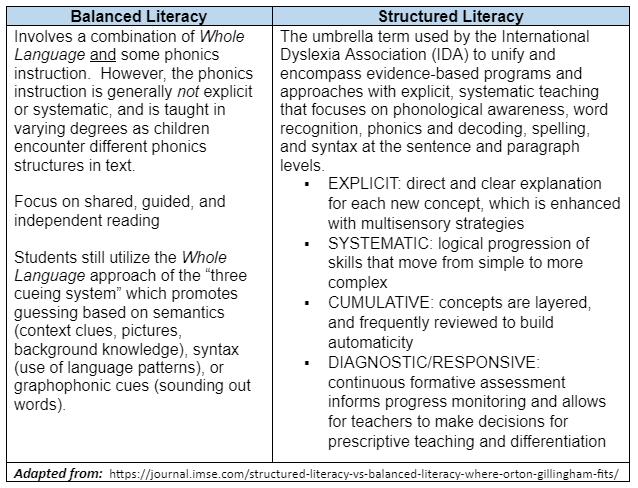
The term “Structured Literacy” was coined and trademarked by the International Dyslexia Association (IDA), and refers to reading instruction and programs that are truly informed by, and delivered consistently with, the Science of Reading. Structured Literacy stands in contrast to a Balanced Literacy approach.
Although many young learners would master expressive and receptive language skills from repeated exposure alone as suggested by Balanced Literacy, there is a population of students for whom this is not sufficient. Particularly for those students with Learning Disabilities. Therefore, utilizing a Structured Literacy approach is best because it avoids making potentially erroneous assumptions about what students are naturally capable of implicitly learning.

By explicitly teaching all concepts, students who readily internalize the patterns of language will learn quickly and easily, and those who otherwise may struggle will get the instruction they need for success.
Moreover, these students are more likely to be identified if specific weaknesses arise in their foundational language skills.
For a more in-depth examination of the components of Structured Literacy, this a great handout:
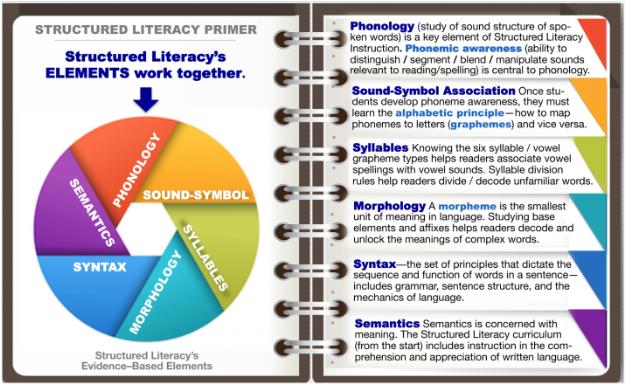
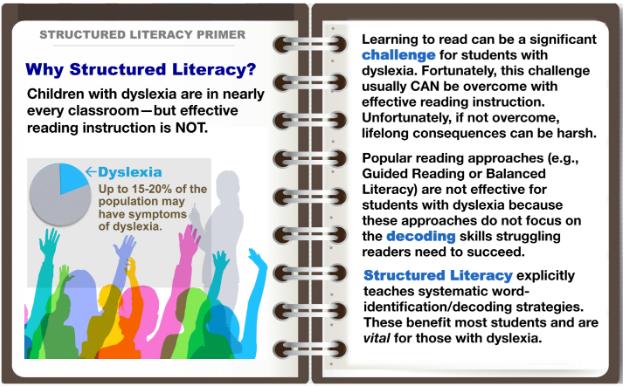
Structured Literacy: Applying the Science of Reading in the Classroom


“Evidence is strong that the majority of students learn to read better with structured teaching of basic language skills, and that the components and methods of Structured Literacy are critical for students with reading disabilities including dyslexia Content of SL
Instruction: Language Dyslexia and most reading disorders originate with language processing weaknesses. Consequently, the content of instruction is analysis and production of language at all levels: sounds, spellings for sounds and syllables, patterns and conventions of the writing system, meaningful parts of words, sentences, paragraphs, and discourse within longer texts” Structured Literacy: Effective Instruction for Students with Dyslexia and Related Reading Difficulties

The overarching message is that learning to read is a complex process involving multiple abilities, skills, and knowledge Each is essential but none is sufficient on its own With that as prologue, here are my ten maxims:
1. Almost all children learn to speak naturally; reading and writing must be taught.
2 Literacy begins at birth It is rooted in early social interactions and experiences that include regular exposure to oral language and print. Strong roots tend to produce stronger readers.
3 All good readers are good decoders Decoding should be taught until children can accurately and independently read new words. Decoding depends on phonemic awareness: a child’s ability to identify individual speech sounds. Decoding is the on-ramp for word recognition
4. Fluent readers can instantly and accurately recognize most words in a text. They can read with expression and at an appropriate rate for their age. Reading fluency requires comprehension AND it supports comprehension.
5. Comprehension the goal of reading draws on multiple skills and strengths, including a solid foundation of vocabulary and background knowledge.
6 One size does not fit all: use student data to differentiate your instruction
7. Direct, systematic instruction helps students develop the skills they need to become strong readers. Indirect, three-cueing instruction is unpredictable in its impact on word reading and leaves too much to chance
8. These maxims apply to English Learners/Emergent Bilinguals, who often need extra support to bolster their oral language as they learn to read and write in a new language.
9. We should support students who speak languages or dialects other than General American English at home, by honoring their home language and by giving them expanded opportunities to engage with General American English text.
10.To become good readers and writers, students need to integrate many skills that are built over time


Alberta Education’s 2021 curriculum included current best practices for reading instruction, and sets our clear expectations for students to develop accurate, automatic, and expressive reading skills in all grades. There is a defined requirement to learn and apply phonological awareness, and phonics, as well as clear expectations for students to build vocabulary and morphology (word parts) from grade to grade These references appear to align with the SoR, however, the new curriculum does not provide specific methods, programs, or resources to easily facilitate this goal. As a leader in Learning Disabilities, it is particularly important that we lead the charge in adopting a Structured Literacy approach. However, it is equally important the we adopt an approach that provides staff members with the structure, guidance, and resources that allow a Structured Literacy approach to be adopted in a feasible way that can support long-term fidelity to the program
The IDA recognizes a number of approaches and programs that meet the standards of Structured Literacy.
“Structured Literacy™ does not involve just one particular program or method. In fact, many well-known intervention programs, methods, and approaches fall under the umbrella of Structured Literacy™, such as the Wilson Reading System (Wilson, 1988), the Orton-Gillingham method (Gillingham & Stillman, 2014), the Lindamood Phoneme Sequencing Program (LiPS; Lindamood & Lindamood, 1998), and Direct Instruction (e.g., Carnine, Silbert, Kame’enui, & Tarver, 2009), as well as several other approaches (e.g., Birsh & Carreker, 2019).” from page 7 of IDA's Structured Literacy: An introductory guide.
As noted in the IDA quote above, the LiPS program used by the Read/Write & Math program does fit within the Structured Literacy realm, however, the Lindamood Bell programs are not easily adapted for a school classroom situation. And, while the Orton-Gillingham method is considered a gold standard of reading instruction, it involves years of training, and is also not easily adaptable to the classroom. However, we have identified the set of Wilson programs, that are based upon the Orton-Gillingham method, which provide a continuum of evidencebased interventions and resources – some of which are specifically designed for easy adoption for group interventions in the classroom
At Foothills Academy Society, our students' learning needs come first. We believe our students are capable learners and we seek to support their learning by using evidence-based programs By adopting an agency-wide Structured Literacy framework, Foothills Academy Society supports the development of literacy skills at all levels of learning in all of our students

The three evidence-based Wilson programs encompass K-12, and provide robust resources and progress-monitoring systems which recognize the practical challenges facing teachers trying to implement Structured Literacy in classrooms (Wilson Language Training - Achieving Literacy for Life)
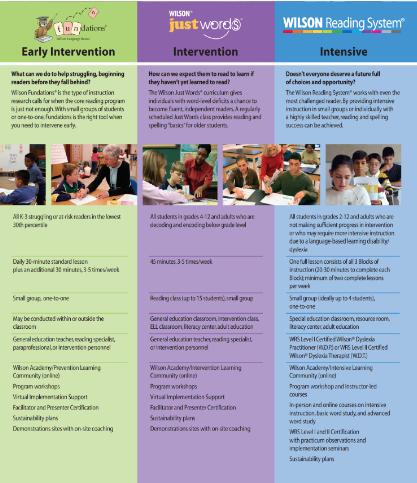
In the School, two of the Wilson programs - Fundations or Just Words (depending on grade level) can be delivered in the classroom, as well as one-to-one, or small groups as part of the Tier 1 and Tier 2 interventions
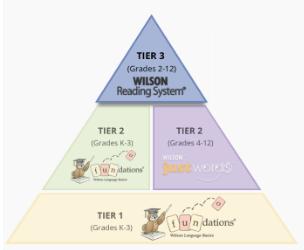
The most intensive Wilson program, the Wilson Reading System (WRS), has Accreditation Plus status with the International Dyslexia Association WRS has been demonstrated to be effective with LD students through imaging of activation in the brain (e.g., Meyler et al., 2008), and through curriculum-based measurement data (e.g., Duff et al., 2015). Starting in September 2021, the full-time Instructors in the Read/Write & Math department can offer this program to School students who are identified as being in need of Tier 3 intervention (at least until a time when the school staff may have this capacity)

The Lindamood Bell programs provide a complimentary set of remedial intervention programs that are primarily delivered in a one-to-one, or small group basis (LindamoodBell Instruction for Reading & Comprehension (lindamoodbellcom))

In the School we incorporate concepts of the Lindamood Phoneme Sequencing (LiPS) program within the Team 1 classrooms, and deliver it directly to those students individually or in small groups as needed.
The full-time Instructors in the Read/Write & Math department are trained to deliver LiPS, as well as Seeing Stars (SI) and Visualizing & Verbalizing (V/V) to students one-to-one and in small groups SI is aligned with the Orton-Gillingham approach, and has been demonstrated to create rapid changes in the white matter of the brain (Huber et al., 2018). Read/Write & Math Instructors can offer their services to School students identified as being on Tier 3.
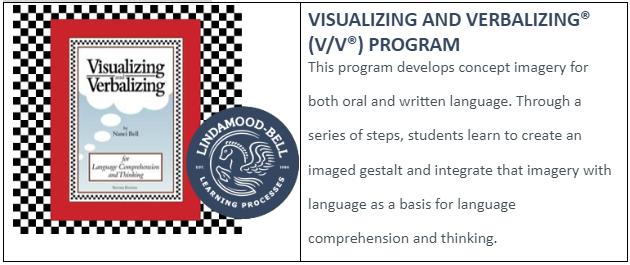

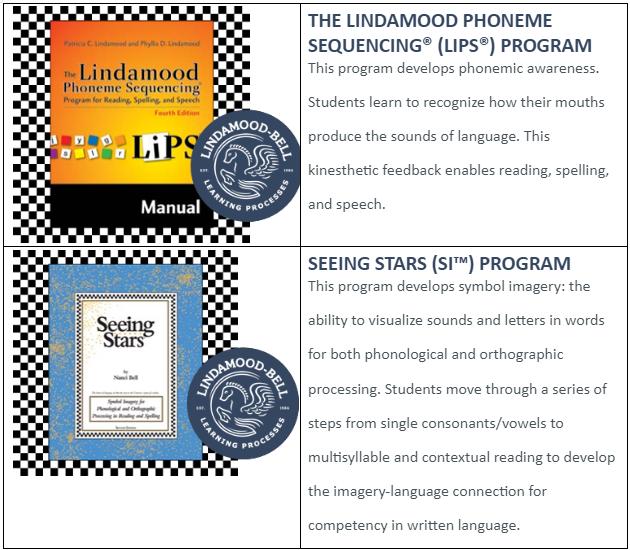


Lexia Reading is a computerized reading program that provides phonics instruction and gives the student independent practice in basic reading skills in two to five weekly sessions of 20–30 minutes each. Lexia Reading is designed to supplement regular classroom instruction and to support skill development in the five areas of reading instruction identified by the National Reading Panel The student works independently, and the software tracks student responses and automatically provides additional practice when needed with internet-based reports for educators on progress.
The Step-Up to Writing program is designed to support a student’s success in writing skills with material and resources available for K-12. This program provides variation and differentiation based on the student’s needs and utilizes a multi-sensory approach. The Step-Up to Writing program provides a teacher’s manual, reproducible handouts, handy pages, classroom posters, digital resources, customizable tools, and bonus materials

The choice of instructional program(s) is driven by the needs of the student; instructional decisions should be based upon specific identified deficits
All students begin on Tier 1 with classroom intervention, however ongoing assessment will identify those students who need to be moved to Tier 2 or Tier 3

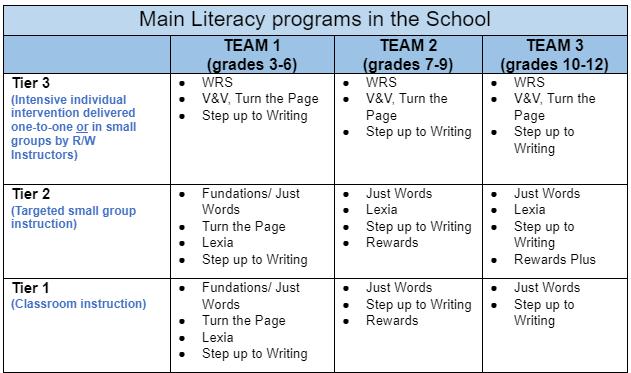
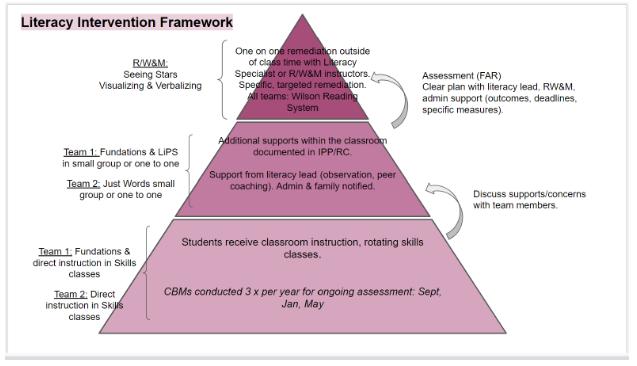

**CBMs conducted three times during the course of the year (September, January, May) all students have CBMs throughout the year.
At a practical level in the classroom, if students are past the initial stages of reading development, the interventions teachers provide to those students (which may look more similar to the more traditional Balanced Literacy approach to reading).
When thinking about Structured Literacy in the classroom, we need to consider the amount and type of structure a student needs. How? Through careful and ongoing assessment, we can determine what programs to use based on the needs of the student. If we consider Guided Literacy as meeting the needs of Tier 1 students, we are planning instruction for students reading at or above grade level in their reading They still have needs for direct instruction in sentence structure, essay writing, building vocabulary, and comprehension This approach is important for building instruction to meet the needs of students reading 1-2 years below grade level. They need structured lessons to focus on phonics, fluency, spelling, and sentence structure with the goal of moving them to guided instruction. Foundational instruction is meeting the needs of students reading more than two grades below their current grade level. These students need intensive and focused instruction in phonics and then orthographic mapping to build toward more advanced instruction Students might move between the Tiers in their needs depending on growth and intervention. At every level there is assessment, direct and explicit instruction - Structured Literacy.
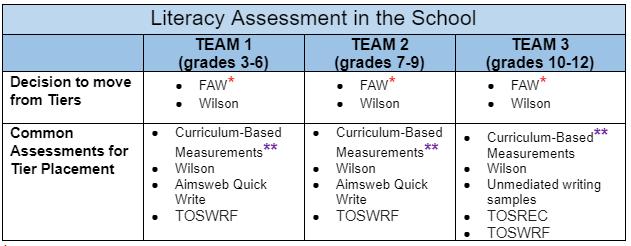 *Level B assessor
*Level B assessor

Parents often ask: “Is my child reading at grade level?’
Within our Structured Literacy approach, assessments are used to drive instruction and group students based on both areas of strength and need regarding reading fluency and comprehension skills. Grade levels are often more arbitrary grouping levels that you would find primarily in a Balanced Literacy approach At Foothills Academy, we do not focus on grade levels but rather aim to focus on:

Curriculum-based measurement (CBMs) are “scientifically validated form of student progress monitoring in which teachers use standard methods for test development, administration, scoring, and data utilization with students involved in the curriculum, as teachers evaluate the effectiveness of instructional changes” (O’Shea & Katsafanas, 2010, p. 571). CBMs are given 3-4 times a year to monitor progress and to make programming decisions. These are an alternative to traditional assessment practices, and offer a system for using curriculum as a diagnostic tool and provide a format for management of instruction. It is based on three central themes: (a) curriculum provides the most basic and meaningful avenue for classroom assessment; (b) curriculum places explicit demands upon the learner; and (c) curriculum must be controlled if academic success is to be achieved.
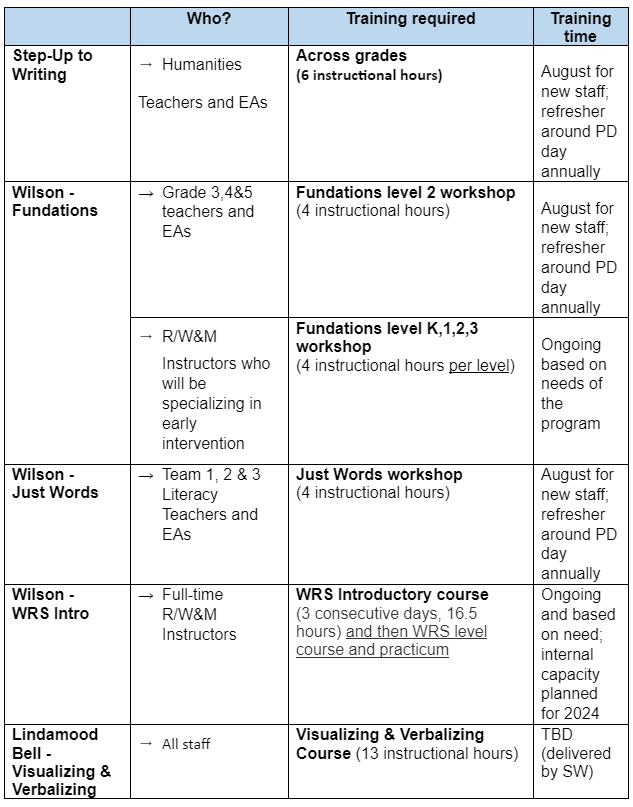

(all of these journal articles can be found in the google drive folder)
Dick, B D, Kaplan, B J, & Crawford, S (2006) The influence of family history on reading remediation and reading skills in children with Dyslexia Canadian Journal of School Psychology, 21 (1), 106-119.
Duff, D, Stebbins, M S, Stormont, M, Lembke, E S, & Wilson, D J (2015) Using curriculumbased measurement data to monitor the effectiveness of the Wilson Reading System for students with disabilities: An exploratory study. International Journal on Disability and Human Development, 15(1), 1-8.
Hale, J. B., Chen, S. H. A., Tan, S. C., Poon, K., Fitzer, K. R., & Boyd, L. A. (2016). Reconciling individual differences with collective needs: The juxtaposition of sociopolitical and neuroscience perspectives on remediation and compensation of student skill deficits Trend in Neuroscience and Education, 5, 41-51
Huber, E., Donnelly, P. M., Rokem, A., & Yeatmen, J. D. (2018). Rapid and widespread white matter plasticity during an intensive reading intervention Nature Communications, 9:2260
Meyler, A., Keller, T. A., Cherkassky, V. L., Gabrieli, J. D. E., & Just, M. A. (2008). Modifying the brain activation of poor readers during sentence comprehension with extended remedial instruction: A longitudinal study of neuroplasticity Neuropsychologia, 46, 2580-2592
O’Shea, D. J. & Katsafanas, J. D. (2010). Curriculum-based assessment and students with special needs Education of Children with Special Needs, 571-576
Seidenberg, M S, Borkenhagen, M C & Kearns, D M (2020) Lost in Translation? Challenges in Connecting Reading Science and Educational Practice. Reading Research Quarterly, 55(S1), S119–S130.
Stevenson, N A & Reed, D K (2017) To change the things I can: Making instruction more intensive. Intervention in School and Clinic 2017, 53(2), 74–80.


